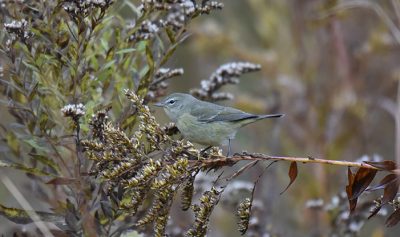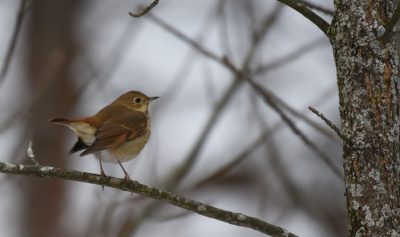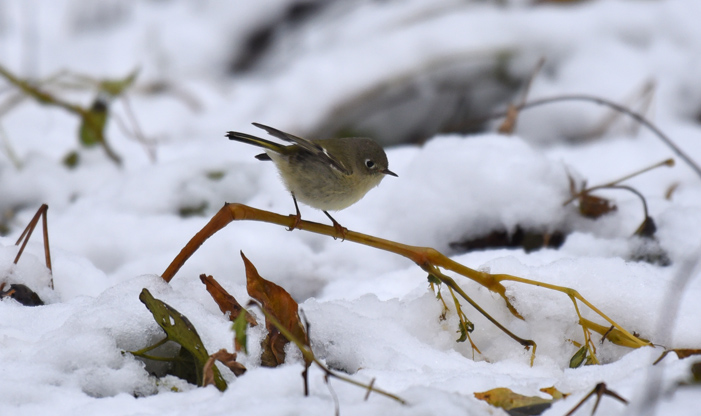Snowstorms like last week’s and the one forecast for tomorrow can have a significant impact on late migrating birds. Any rapid change in weather can catch bird species off guard, especially those that aren’t specifically able to handle the change in temperature and the accumulation of snow. Last week, we saw a number of birds at the Center that were affected by the early snowstorm.
What Happens to the Late Migrants
When it gets snowy and cold in fall, some bird species are able to handle it, like the Dark-eyed Juncos who are arriving here for the winter. However many are not well equipped and have a hard time gathering food, as well as staying dry and warm. Some tinier species, like the Ruby-crowned Kinglet, are more affected by cold weather. These birds will need to find shelter in a cavity or shrub, and some species huddle together to stave off the chill. They will often puff up their bodies to trap the warm air.
Diets in the Cold and Snowy Conditions

Orange-crowned Warbler foraging at the Center.
One of the main challenges for birds is getting food. Birds that are mainly insectivores, including the Orange-crowned Warbler and the Ruby-crowned Kinglet, have a harder time finding insects in the cold snow. As late migrants, they are already stressed from their journeys, so having a difficult time finding food adds to their struggles. Their species is not adapted for the onslaught of winter weather, so they must be able to locate a food source to continue southwards.
On most counts, berry eaters do well even when the weather is cold. Berries are plentiful, and any berry-eating species will be well supplied with nutrition. Cedar Waxwings eat the berries of the Juniper tree. This bird species is abundant right now, in a large part because of its diet.

Hermit Thrush in the recent snowstorm.
The Hermit Thrush is able to adapt to this weather change because it can switch its diet to berries, which are plentiful in October. Having the ability to eat berries is one factor that can bolster a bird’s chances of surviving winter. Birds that don’t have the right kind of beak or the digestive enzymes to change their diet are hampered when the weather changes rapidly.
Being a seed eater makes it easier to get food, unless there is deep snow that persists. The Fox Sparrow is able to take advantage of being a seed eater, even moving the snow with its feet to get to the seeds. The late migrating Fox Sparrow is also able to deal with cold weather because it has enough body mass to handle the cold.
How to Help Migratory Birds in the Cold
Many birds are stressed by these snowy conditions, but there are a couple of ways you can help late migrants cope. If an early winter storm is in the forecast, keep your bird feeders filled, and consider getting a mealworm feeder to assist the insectivores when they can’t find food. And if you find a weak or injured bird, contact the Wisconsin Humane Society’s Wildlife Rehabilitation Center.
Late migrating birds are more vulnerable to changes in weather than other birds because they are already depleted by the energies they’ve spent migrating. Oftentimes, their bodies are not adapted to necessary dietary changes that would allow them to better cope with cold and snow. Conditions like these can be good for predators, as there are more vulnerable birds available as prey. Though many birds at the Center are still migrating through, there are a number of them here to stay, like the Dark-eyed Junco and the American Tree Sparrow. Visit soon to see the last of the remaining late migrants, and remember that there will be overwintering birds here when migration is over.


